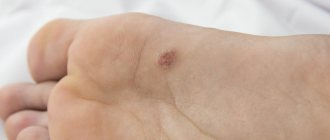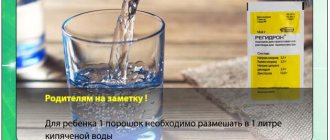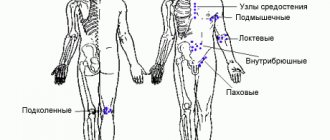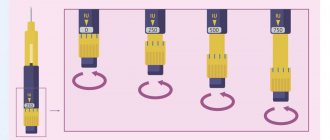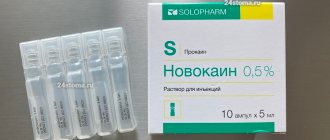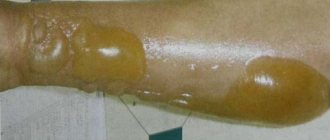Dimexide is a transparent liquid or crystals at air temperatures of 20 degrees and below. The drug contains dimethyl sulfoxide.
Dimexide solution anesthetizes, relieves inflammation and disinfects.
Dimexide liquid has a specific odor and a yellowish tint. The drug is diluted with water in certain proportions and Dimexide compresses are applied with the prepared solution. This substance was actively used during the First World War to treat injuries, wounds, and fractures. After Dimexide was discovered to have an abnormal ability, in addition to its anti-inflammatory and analgesic effects, to be a good conductor, interest in it increased and in 1960 it was put into industrial production.
Composition of Dimexide
The concentrate for preparing Dimexide solution contains at least 99% dimethyl sulfoxide (DMSO) undiluted.
Dimexide gel contains DMSO at a concentration of 0.25 mg/g or 0.5 mg/g, as well as nipagin, nipazole, sodium carmellose, and purified water.
Dimexide ointment is prepared on the basis of polyethylene oxide 1500 gel (an emulsifier is added to it to give the preparation the necessary consistency) or on the basis of mink oil. The concentration of the active substance is from 30 to 70%.
DMSO is also included in some gels and ointments ( Triacort , Dolobene , Chondroxide , Capsicam , Remisid , Ketorol) , but in them it acts as a penetrator and is not an active substance.
Contains DMSO and Propolis-D . In addition to this substance, the medicine contains propolis extract 20% and cocoa butter.
How to properly dilute dimexide with novocaine
In some cases, a compress containing only Dimexide and water is ineffective. In this case, you can add novocaine to the solution. It will have an additional anesthetic effect. There is another way to enhance the analgesic effect, which is to use aqueous propolis instead of novocaine (this is a separate topic).
novocaine
To prepare the solution we need:
- dimexide: 1 part
- 2% Novocaine solution: 2 parts
- distilled water: 3 parts
Pour all ingredients into a glass container and mix well.
Pharmacodynamics and pharmacokinetics
Dimexide - what is it?
To the question “What is Dimexide?” Wikipedia answers that this is an external drug that is used primarily to relieve pain and inflammation in diseases of the musculoskeletal system (MSD), as well as to enhance the penetration of a number of other drugs into tissues.
Pharmacodynamics
The mechanism of action of DMSO is associated with the ability of this substance to inactivate hydroxyl radicals and improve the course of metabolic processes in the site of inflammation.
The drug has a local analgesic and anesthetic effect . Shows moderate fibrinolytic and antiseptic activity.
DMSO helps normalize the processes of fibrin formation, improves microcirculation in tissues, inhibits erythrocyte and neutrophil , increases the activity and intensity of phagocytosis , and reduces the content of CEC.
When applied topically, it quickly and well passes through biological membranes (mucous membranes, skin, bacterial cell walls), increasing their permeability to other drugs.
These properties of DMSO allow it to be used as a transporter of other drugs through mucous membranes and skin.
Pharmakinetics
When applied to mucous membranes or skin, it is absorbed quickly and almost completely.
Bioavailability - 60-70%. Moreover, the penetration depth and bioavailability of DMSO are directly proportional to its concentration.
After application to the skin, the drug is detected in the blood serum within ten minutes. Concentrations reach peak values after four to eight hours.
Penetrates well into tissue cells of all organs. The exception is cells of nails, hair, and tooth enamel.
In the body, DMSO is oxidized to methylsulfonylmethane and then reduced to dimethyl sulfide.
The active substance and its metabolic products are excreted in feces and urine. In addition, DMSO can be excreted through the lungs and skin, which is accompanied by the appearance of a specific garlic odor.
Even with long-term use of Dimexide, DMSO and its metabolites do not accumulate in the body.
Indications for use of Dimexide
Dimexide has been approved for medical use since 1971. Indications for use of the medicine:
- sprains;
- edema of various etiologies;
- purulent wounds;
- phlegmon;
- trophic ulcers;
- lymphostasis;
- burns;
- hemorrhages in the joints;
- thrombophlebitis (acute or chronic);
- eczema;
- erysipelas;
- diffuse streptoderma;
- keloid scars;
- discoid lupus erythematosus;
- limited scleroderma ;
- alopecia;
- pyoderma;
- erythema nodosum;
- furunculosis;
- acne.
According to the manufacturer's instructions, applications with Dimexide are prescribed for diseases of the musculoskeletal system such as deforming osteoarthritis (in case of damage to periarticular tissues), ankylosing spondylitis , rheumatoid arthritis , reactive synovitis , radiculitis . The drug is used in combination with other drugs and procedures.
Dimexide is effective for bruises and gout ; it is used to accelerate the resorption of traumatic infiltrates and to treat heel spurs.
For a number of neurological diseases, as well as when it is impossible to use oral forms of NSAIDs (for example, with peptic ulcer electrophoresis with Dimexide may be recommended This method of treatment is used when it is necessary to relieve joint pain, pain due to osteochondrosis or post-traumatic pain (including if the patient has a damaged nerve).
In skin plastic surgery, Dimexide is used for the preservation of skin homografts , as well as for the treatment of transplanted skin homo- and autografts .
In dental practice, the product is used for inflammatory processes in the maxillofacial area and inflammatory damage to the salivary glands , for pulpitis , periodontitis , periodontitis , arthritis/atrosis of the temporomandibular joint .
Indications for use in gynecology are colpitis , cervical erosion , endometritis , adnexitis , thrush , complications developing after gynecological operations and childbirth, etc.
Due to its bactericidal and anti-inflammatory properties, the drug is often used in cosmetology. A mask with Dimexide and Solcoseryl is considered one of the most effective remedies for wrinkles and the best replacement for mesotherapy and Botox , and compresses and wraps with the solution help reduce the appearance of cellulite . In addition, cosmetologists recommend the drug as an anti- acne .
Hair masks with natural oils and Dimexide reduce hair loss and stimulate hair growth.
Compresses for treating wounds
If it is necessary to apply Dimexide to the wound, then it is used in the form of a compress . Many people refuse this option because of the unpleasant odor of the solution.
The compress should not be used for longer than one hour. If long-term exposure is necessary, apply as a wet bandage.
Carefully monitor the concentration; it is necessary to dilute in a certain proportion. Prolonged contact with a highly concentrated solution can negatively affect the condition of the skin.
Contraindications
Contraindications for use:
- intolerance to the components of the drug;
- liver/kidney failure;
- stroke;
- severe atherosclerosis ;
- angina pectoris;
- myocardial infarction;
- cataract;
- glaucoma;
- coma;
- pregnancy;
- lactation.
When prescribing a drug, take into account the fact that it can enhance not only the activity, but also the severity of the toxic effects of a number of drugs.
When even a small amount of dimethyl sulfoxide is swallowed, as well as when used for applications in the oral cavity, the patient may experience stomach upset or intestinal spasms.
Recommended proportions of the drug
The proportions necessary for the treatment of open wounds are prescribed by the doctor.
Concentrations of Dimexide solution in the treatment of various skin lesions:
- 55% - therapy of erysipelas of the skin;
- 40% - treatment of streptoderma and purulent rashes;
- 30% - treatment of second and third degree burns;
- 25% – pain relief;
- 15% - in the presence of an allergic reaction to the components of the drug.
The concentration of the solution may vary depending on the area of application of the compress. On sensitive areas of the skin the concentration should be lower. If Dimexide is used to wash wounds, then its concentration should be lower.
Instructions for use of Dimexide (Method and dosage)
Dimexide solution: instructions for use
A solution based on Dimexide concentrate (Dimexide Zhff, Dimexide Lugal) is used as a means of external therapy. It is used for washing affected body surfaces (irrigations) and in the form of applications.
Moisten a gauze pad in a solution of the required concentration and apply it to the affected area for 20-30 minutes. The top of the napkin is covered with plastic film and linen (or cotton) cloth. It is recommended to repeat the procedures 1-3 times/day (depending on the indications) for 10-15 days.
How to dilute Dimexide concentrate depends on the purpose for which the medicine is being prepared.
To treat trophic ulcers, a 30-50% solution of dimethyl sulfoxide is used (for one treatment, 50 to 100 ml of liquid is used), eczema - a solution with a concentration of 40-90%.
For local anesthesia, the drug is used 2 or 3 times a day in the form of compresses with a 25-50% solution. Single dose - from 100 to 150 ml.
For joint pain (for example, with atrosis of the knee joint), lotions on the joint with the drug diluted to the same concentration are indicated. Compresses with Dimexide for the knee or ankle are applied for 20-60 minutes. The course is designed for 15-20 procedures.
If the lesion is localized in a highly sensitive area of the body, the concentrate is diluted to obtain a 10-30% solution.
For patients who have undergone skin plastic surgery, bandages impregnated with a 10-20% Dimexide solution are applied to the transplanted homo- and autografts immediately after the operation and subsequently until the transplant is permanently engrafted.
To preserve skin homografts, a 5% solution of DMSO in Ringer's solution is used.
Less concentrated solutions are used for washing inflammatory and purulent-necrotic lesions and cavities.
Gel Dimexide: instructions for use
The gel (ointment) is used as a means of external therapy to treat patients over 12 years of age.
The product is applied to the affected area of the body in a thin layer from 1 to 3 rubles/day. Gel 50% is intended for treating the skin; for mucous membranes it is recommended to use gel 25%. The course lasts from 10 to 15 days. It can be repeated no earlier than 10 days later.
For diffuse streptoderma , eczema , as well as for local anesthesia, applications with gel (50%) in the form of compresses are used. The procedure is repeated 2-3 times during the day.
For thrombophlebitis, the patient is prescribed simultaneous applications of Dimexide with heparin gel or heparin ointment . Applications should be done 2-3 rubles/day. The course is designed for 10-15 procedures.
In skin plastic surgery, dressings with 25% gel are applied to skin homo- and autografts . The first bandage is applied immediately after the operation, and further procedures should be repeated until the implant is firmly engrafted.
How to dilute the drug for joints for gout?
For diseases of the rheumatic type (in particular, gout ), compresses with Dimexide can significantly reduce pain and quickly relieve inflammation in them.
Penetrating well into the tissue, the drug promotes the gradual dissolution of salt build-ups on the joints of the small bones of the foot and joints affected by the pathological process.
To prepare a compress, the concentrate is diluted in an equal volume of water at room temperature. Then a piece of gauze is folded into several layers, soaked in the resulting solution, applied to the sore spot and insulated with polyethylene, cotton cloth and a woolen scarf.
Exposure time is from 20 minutes to half an hour. Treatment, depending on the degree of joint damage, lasts from 10 days to 2 months.
Since Dimexide is a good transporter of other drugs, before using it, to enhance the effect, you can lubricate the sore joint with anti-inflammatory ointment/gel ( Bystrum-gel , Chondroxide and their analogues).
To relieve intense pain, Dimexide (30 ml) can be mixed with a two percent solution of Novocaine (50 ml). The bandage is applied in the same sequence. Exposure time is from 30 minutes to 1 hour.
How to dilute Dimexide for a compress for heel spurs?
With a heel spur, to alleviate the patient’s condition and improve his quality of life, Dimexide is used in small dosages in the form of compresses or rinses.
To prepare the solution, the concentrate is diluted with water in a ratio of 1:5. Then a napkin soaked in liquid is placed on the sore heel and a sock is put on top. Exposure time: 30 minutes.
The effect of the procedure will be more pronounced if you rub anti-inflammatory ointment into the sore spot 15 minutes before applying the compress.
of Hydrocortisone , Dropiredol , Novocaine , Analgin to the Dimexide solution . This composition gives the best anti-inflammatory and analgesic effect. The compress should be removed no later than after 40 minutes, otherwise skin irritation may occur.
Why is Dimexide used in pediatrics?
In children, Dimexide is used to treat diseases of the musculoskeletal system , inflammatory , purulent and ulcerative skin lesions , erysipelas , eczema , streptoderma , burns , as well as diseases of the upper respiratory tract .
Compresses with the drug warm up well, stop the inflammatory process and relieve coughs that irritate the throat. This treatment is appropriate for pharyngitis , tonsillitis , and sore throat .
The proportions of the Dimexide compress with Novocaine for cough are as follows: three to four parts of water to one part of the concentrate (the younger the child, the less concentrated the solution should be prepared).
To prepare the composition, you can use two parts of the concentrate: one part water, one part juice squeezed from aloe stems and two parts honey melted in a water bath. Before use, the mixture is slightly warmed.
Gauze folded five times and soaked in the resulting mixture is applied to the throat and secured first with polyethylene and cotton cloth, and then with a scarf. Remove the compress after 50 minutes (earlier if a burning sensation occurs).
It is better to carry out the procedure at night.
For bronchitis , compresses with Dimexide help relax the bronchi and improve blood circulation.
The instructions for a compress with Dimexide and Novocaine for a child are as follows: one tbsp. a spoonful of concentrate is diluted in the same volume of boiled/distilled water, then diclofenac sodium (one ampoule) and 10 ml of a two percent solution of Novocaine .
Gauze soaked in the product is applied to the feet, back (in the area of the shoulder blades) and chest, covered with polyethylene and secured with a bandage (scarf). The child is covered with a blanket. The duration of the procedure is 30 minutes. Compresses are applied once a day for a week and only if the child has a normal temperature.
The medicine is used warm (but not hot!). When applying gauze to the chest, avoid the heart area.
Contraindications for use in pediatrics are pathologies of the heart, blood vessels, kidneys and liver, problems with the immune system, age under 12 years, elevated body temperature.
Application in gynecology: how to make tampons with Dimexide?
Dimexide is used in gynecology in the form of vaginal tampons. To prepare a medicinal mixture, one part of the concentrate is diluted in five parts of water, and then aloe juice, antibiotics or Lidase .
Ready-made tampons that women use for menstrual bleeding are not suitable for treatment, since they are often impregnated with various compounds that can react with dimethyl sulfoxide. Therefore, tampons should be made independently from sterile cotton wool.
The tampon should be inserted into the vagina in such a way that it can be easily removed. The active substance is quickly absorbed, penetrating the inflamed ovaries or uterus even with shallow injection.
The duration of each procedure, as well as the duration of the course, depend on the degree of neglect of the pathological process.
Propolis-D as an adjuvant .
Due to the presence of propolis and DMSO in these suppositories, they provide good pain relief, stop the inflammatory process, have an antibacterial effect, help strengthen the immune system and increase the effectiveness of basic therapy.
They should be used twice a day, one at a time, for 10-14 days.
Dimexide for hair
The use of Dimexide in combination with natural oils and vitamins helps improve the structure and accelerate hair growth. What is dimethyl sulfoxide? A conductor for other substances and a universal stimulator of metabolic processes.
Mask with Dimexide for oily hair: one part of Dimexide concentrate, one part of ampoule solutions of vitamins A and E, one part of lemon juice (the juice can be replaced with vodka, cognac or 70-degree alcohol if desired). This composition should be left on the hair for no more than half an hour.
A mask for oily hair based on Dimexide (1 teaspoon), macadamia oil (1 teaspoon), almond oil (1 teaspoon), eggs (1 piece), cognac (1 tablespoon) also earned good reviews from trichologists. ). The mixture is applied to the hair for half an hour, then washed off with shampoo and rinsed with water and lemon juice.
To prepare a mask for hair growth and strengthening hair follicles, you need to mix castor and burdock oils taken in equal volumes, add to them oil solutions of vitamins E and A (one ampoule each) and 5 drops of lemon juice. Mix the ingredients thoroughly and add 1 tbsp. a spoonful of Dimexide concentrate.
After the composition is applied to the hair roots, a plastic cap is put on the head and tied with a towel. After an hour (if a burning sensation occurs - immediately), the hair is washed with shampoo.
A similar composition in which lemon juice is replaced with the yolk of one egg also works well on hair.
To stimulate hair growth, use a mask with sea buckthorn oil. To prepare the composition, mix the heated oil with the concentrate in a 3:1 ratio. The mixture is rubbed into the hair roots, insulated with polyethylene and a towel, and washed off after an hour. Instead of a rinse aid, at the end of the procedure you can use apple cider vinegar diluted with water in a ratio of 1:10.
Reviews about Dimexide for hair growth are mostly positive, but it should be remembered that the drug is a powerful pharmaceutical that has a number of contraindications and can cause a fairly severe burn.
Dimexide for face
In facial cosmetology, Dimexide is used to improve the condition of aging skin, as well as to treat problematic skin prone to rashes.
A very effective remedy for combating wrinkles and rejuvenating the face is a mask made from Dimexide and Solcoseryl . To begin with, you should dilute one volume of concentrate in ten volumes of boiled water and thoroughly wipe your facial skin with this solution. Then Solcoseryl .
The duration of the procedure is one hour. During this entire time, the mask must be sprayed with warm water so that it does not harden. After an hour, the gel (or ointment) is removed with a damp cotton swab, and the skin is moisturized with cream.
To prevent wrinkles, the mask can be done 1-2 times a month, if there are deep wrinkles - once every three days for a month.
An equally popular care product is a face mask with Dimexide and melaleuca (tea tree) oil. This composition is good at treating purulent-inflammatory skin lesions.
To prepare the mask, you need to mix equal volumes of a 10% aqueous solution of Dimexide and essential oil. The product is applied to the face using a cotton sponge for several hours or overnight, and then the residue is washed off with warm water. If a burning sensation occurs, wash off the mask immediately.
Dimexide for acne
The easiest way to use it for acne is to daily wipe the acne- areas with Dimexide solution (DMSO concentration - no more than 10%). The procedure is repeated twice a day.
However, reviews indicate that better results can be achieved using more complex mixtures.
You can dissolve two Erythromycin in a 10% solution of the drug, or you can mix four tablespoons of concentrate with 50 ml of two percent salicylic alcohol , 40 ml of glycerin and the contents of 10 ampoules of a ten percent solution of Dioxidin.
Both formulations should be applied to problem areas of the skin twice a day.
A very powerful remedy for acne is a composition prepared from 40 ml of salicylic alcohol (2%), 10 tablets of Metronidazole , 10 capsules of Doxycycline , and 10 ml of Dimexide (the concentrate is added last).
Dimexide for cellulite
The drug has a vasodilating effect and helps restore metabolic processes throughout the body, which allows it to be used to combat cellulite.
To reduce the “orange peel”, the product is used in the form of applications and compresses, after mixing with distilled water. Optimal proportions are selected depending on the zone for which the drug will be used.
For the thighs, the concentrate is diluted with water in a ratio of 1:1, for the armpits, neck and arms - in a ratio of 1:20 or 1:10.
Then gauze soaked in the resulting solution is applied to problem areas, covered with polyethylene, insulated and left on the skin for 50 minutes. The course is designed for 12-15 procedures.
Alginate wraps with Dimexide and wraps with Dimexide and seaweed are very popular in cosmetology.
Before starting the wrap, it is recommended to take a warm shower (or bath) and cleanse the skin with a fine-grained scrub. Then the skin of problem areas of the body is wiped with a cotton pad soaked in Dimexide solution.
For women with sensitive skin, the drug should be diluted with one volume of concentrate in three volumes of distilled or boiled water. If there is no allergy to the medicine, it is used in its pure form.
To treat the legs and abdomen, 1 teaspoon of solution is enough. After applying Dimexide, an anti-cellulite agent is rubbed into the skin. When it is absorbed, begin preparing the alginate. Since the drug hardens quickly, it should be prepared very quickly.
Alginate diluted in water is distributed over the skin, wrapped on top with two layers of foil (cling film) and a terry towel. Exposure time is from 40 minutes to one hour. There is no need to rinse off the product after wrapping. Simply apply cosmetic milk or moisturizer to your legs and stomach.
Seaweed wraps are made using the same principle.
Additional recommendations
1Do not keep the compress for longer than the recommended time - this can lead to chemical burns, allergies and other adverse consequences. 2Use only a special soft cloth or sterile bandage (gauze, cotton wool). Dimexide quickly reacts chemically with residues or contaminants on the fabric and penetrates deeply into the skin. Using dyed (or unclean) fabrics can lead to allergies. 3The solution must be prepared only before use. 4The prepared solution can be used within 12 hours. Do not reuse the solution and compress with dimexide even after its use has expired.
If you find an error, please select a piece of text and press Ctrl+Enter.
The information on the portal is exclusively encyclopedic in nature and is intended for specialists. Do not use these recommendations for self-medication.
All materials are protected by copyright. In case of copying an article (or part of it), an active link to the source is required.
Interaction
DMSO increases absorption and enhances the effects of a number of other drugs (including insulin) and ethanol.
Compatible with NSAIDs, antibacterial drugs , heparin .
Increases the sensitivity of microflora to beta-lactam antibiotics and aminoglycosides , rifampicin , chloramphenicol , griseofulvin .
Sensitizes the body to general anesthesia.
special instructions
Some patients smell garlic in the air they breathe.
To determine possible individual intolerance to the drug, before using it, it is recommended to conduct a drug test (the solution is applied to the skin and the patient’s reaction is observed).
Evidence of increased sensitivity is itching and severe redness of the skin.
If during treatment with Dimexide the patient experiences allergic reactions , he should be prescribed an antihistamine .
Non-medical use of the drug or how to clean polyurethane foam?
One of the little-known properties of Dimexide is its ability to remove hardened polyurethane foam well.
To do this, the concentrate should be applied to a cotton swab or sponge, rub it into the surface on which the foam has fallen, and wait a few minutes until the foam begins to become covered with a well-peeling crust. If necessary, the manipulations are repeated several times.
It is necessary to work with rubber gloves so as not to burn the skin of your hands.
How to treat a burn from Dimexide?
You can get a burn from Dimexide if the drug is diluted incorrectly, as well as if it is used undiluted.
Photo of a burn with Dimexide:
What to do in case of a burn? A cabbage leaf applied to the burned area is good for soothing irritated skin (it can be secured with a bandage on top).
Panthenol diluted in water at room temperature . In case of severe burns, you can use ointment with corticosteroids ( Hydrocortisone or Prednisolone ).
Solutions are used for compresses
Dimexide compresses are applied to the site of inflammation.
- For trophic ulcers, use a 30-50% Dimexide solution 2-3 times a day.
- For eczema - 40-90% solution.
- For boils - 40% Dimexide solution.
- For pain relief - 25-50% solution, local compress 2-3 times a day.
- For burns - 20-30% solution.
- For increased sensitivity, use a 10-20% solution.
For children 9-18 years old, use a 20-30% Dimexide solution. Children 6-9 years old only as prescribed by a doctor. Dimexide is not used for children under 6 years of age.
If it is necessary to change the method of application, the doctor will give recommendations.
Analogs
Level 4 ATX code matches:
Dolobene
Nayatoks
Finalgon
Apizartron
Bee venom
Gavkamen
Menthol oil
Gum turpentine
Capsicam
Tizol
Camphor alcohol
Turpentine ointment
Formic alcohol
Mataren Plus
Dimethyl sulfoxide
Fast Relief
Synonyms: Dimexide-Lugal , Dimexide Zhff , Dimethyl sulfoxide .
Analogs with a similar mechanism of action: Alvipsal , Apifor , Artran , Boromenthol , Viprosal , Medical bile , Diclogen , Camphor alcohol , Camphor (ointment/oil), Capsicam , Carmolis , Kolkhuri , Kim , Mataren , Kuznetsov ointment , Pikhtanol , Revma-gel , Chondroxide , Honsurid , Chondroitin , Espol , Eftimethacin .
Reviews of Dimexide
Dimexide is a drug with unique chemical properties. Numerous reviews from doctors confirm the versatility of this remedy.
Dimexide quickly relieves inflammation, relieves pain well, restores the nutritional processes of cells and tissues, improves blood flow in blood vessels, has an antibacterial effect and promotes the dissolution of blood clots.
These properties make it possible to use Dimexide for the treatment of diseases of the musculoskeletal system (compresses are very effective for arthrosis of the ankle or knee joints ) and diseases of the upper respiratory tract , as well as infectious and inflammatory diseases in gynecology .
Reviews of the Dimexide gel are also positive: the product very quickly stops the inflammatory process, removes pus, treats acne, contusions, bruises, osteoarthritis , purulent wounds and thrombophlebitis .
Dimexide is also successfully used in cosmetology. Solcoseryl mask is an excellent alternative to expensive procedures for facial rejuvenation, and reviews of Dimexide for hair allow us to conclude that the use of the drug is one of the most affordable and effective ways to strengthen and activate hair growth.
There are a lot of good reviews about Dimexide for acne. The product “works” both independently and in combination with antibiotics . Some girls add concentrate (a few drops) to clay masks.
As a result, the skin brightens, inflammation dries out, and recovery of the affected areas is accelerated.
Another category of reviews is reviews of Dimexide for cellulite. The product works really well on orange peel. The effect of wraps and applications becomes noticeable after just a couple of procedures, while Dimexide costs significantly less than most anti-cellulite products.
Summarizing the reviews, we can draw the following conclusion - Dimexide is indispensable in a home medicine cabinet, but when using it for cosmetic purposes, it is very important to remember that this is primarily a medicine that has contraindications and can cause allergies and burns.
How much does Dimexide cost in a pharmacy?
Cost of the drug in Russian pharmacies
The price of Dimexide in ampoules (bottles) of 50 ml in Russian pharmacies is from 22 rubles. The cost of 100 ml bottles is from 36 rubles. The price of Dimexide gel is 172 rubles.
Price of Dimexide in Ukraine
The price of Dimexide solution (50 ml) is from 12 UAH. You can buy a 100 ml bottle of concentrate for an average of 21 UAH. Ukrainian pharmaceutical companies do not produce ointment (gel) Dimexide.
- Online pharmacies in RussiaRussia
- Online pharmacies in UkraineUkraine
- Online pharmacies in KazakhstanKazakhstan
ZdravCity
- Dimexide gel for external use
application 25% 30g LLC AVZ S-P/Pharmamed LLC 209 rub. order
Pharmacy Dialogue
- Dimexide (100ml bottle (plastic))Iodine technologies and marketing
RUB 253 order
- Dimexide (bottle 100ml) TCPP
RUB 198 order
- Dimexide gel (tube 25% 30g) Pharmamed/AVZ S-P LLC
210 rub. order
- Dimexide gel (tube 25% 30g) Farmamed
RUB 201 order
- Dimexide (bottle 100ml) Tula FF
RUB 245 order
show more
Pharmacy24
- Dimexide 50 ml solution PAT "Lubnipharm", Ukraine
12 UAH. order - Dimexide 50 ml solution PAT "Galichfarm", Ukraine
15 UAH order
- Dimexide 50 ml solution TOV "DKP Pharm.Fabrika", Ukraine
12 UAH order
- Dimexide 100 ml solution PAT "Lubnipharm", Ukraine
21 UAH order
PaniPharmacy
- DIMEXID liquid Dimexide 50ml Ukraine, Galichfarm JSC
16 UAH order
- DIMEXIDE liquid Dimexide liquid 50ml fl. Ukraine, Lubnyfarm PJSC
13 UAH order
- Dimexide liquid Dimethyl sulfoxide 50ml Ukraine, GEZMP GP
17 UAH order
- DIMEXIDE liquid Dimexide liquid 100ml fl. Ukraine, Lubnyfarm PJSC
24 UAH order
- Dimexide liquid Dimexide solution for external approx. 50ml Ukraine, Zhytomyr FF LLC
14 UAH order
show more


